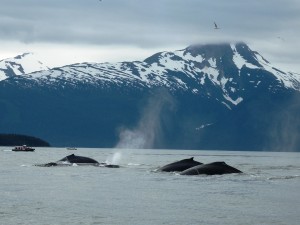» posted on Tuesday, July 24th, 2012 by Linda Lou Burton
Big Gulp
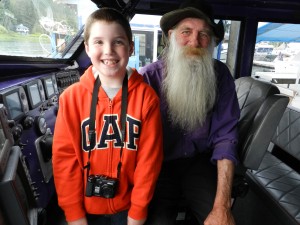 Linda Burton posting from Juneau, Alaska – Captain Larry dropped a slender acoustic device into the water as our boat sat quietly rocking. “We’ll listen for a while,” he nodded, “I want to know if they are coming this way.” Grandson Sam’s eyes got big as “whale talk” filled the boat, the device clearly picking up the underwater sounds. We didn’t know what it meant, but it verified that whales were near. Katie, our on-board naturalist, had already gone up top with her binoculars, watching for the sight of birds, and blow. That’s where the whales would be, we’d learned on the way out from Auke Bay, the “blow” being the burst of air expelled from the whale’s blowholes, or nostrils, as they surfaced, causing a visible spray. Just off in the distance, we’d spotted both, a frenzy of circling birds and geyserlike sprays. That meant whales, whales
Linda Burton posting from Juneau, Alaska – Captain Larry dropped a slender acoustic device into the water as our boat sat quietly rocking. “We’ll listen for a while,” he nodded, “I want to know if they are coming this way.” Grandson Sam’s eyes got big as “whale talk” filled the boat, the device clearly picking up the underwater sounds. We didn’t know what it meant, but it verified that whales were near. Katie, our on-board naturalist, had already gone up top with her binoculars, watching for the sight of birds, and blow. That’s where the whales would be, we’d learned on the way out from Auke Bay, the “blow” being the burst of air expelled from the whale’s blowholes, or nostrils, as they surfaced, causing a visible spray. Just off in the distance, we’d spotted both, a frenzy of circling birds and geyserlike sprays. That meant whales, whales 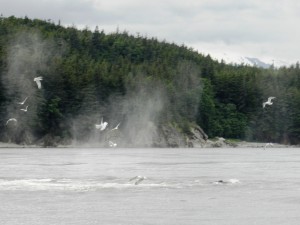 enjoying lunch. “Just like the sight of a parking lot full of cars outside a restaurant,” I thought to myself, smiling, “the sign that it’s a good place to eat.” Then Katie yelled, “It’s Sue! I see Sue!” Captain Larry yanked the device from the water and swung around to start the engine. “I know where they are going now!” he said, and suddenly we were moving again, straight toward the whales. All of us raced to the outside deck as Captain Larry positioned the boat for a perfect view.
enjoying lunch. “Just like the sight of a parking lot full of cars outside a restaurant,” I thought to myself, smiling, “the sign that it’s a good place to eat.” Then Katie yelled, “It’s Sue! I see Sue!” Captain Larry yanked the device from the water and swung around to start the engine. “I know where they are going now!” he said, and suddenly we were moving again, straight toward the whales. All of us raced to the outside deck as Captain Larry positioned the boat for a perfect view.
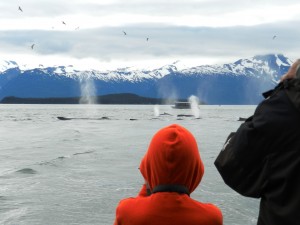 Katie spent a lot of time on the way out explaining “what whales do” and what we were to watch for. The birds, from their vantage point above, spot schools of fish below, and the whales from below watch the birds watching the fish; then everything comes together; it’s chow time. But no patron of McDonalds ever had an idea as clever as what the whales do next. It’s called “bubble net feeding.”
Katie spent a lot of time on the way out explaining “what whales do” and what we were to watch for. The birds, from their vantage point above, spot schools of fish below, and the whales from below watch the birds watching the fish; then everything comes together; it’s chow time. But no patron of McDonalds ever had an idea as clever as what the whales do next. It’s called “bubble net feeding.”
The whales circle the school of fish from below (it takes teamwork to pull this off); then they begin singing and blowing bubbles, scaring the fish and trapping them in a tight school inside a bubble “net.” Suddenly, whoosh! The whales swim up through the fish with mouths wide open, gobbling up their banquet and lunging out of the water as they close their mouths. What a sight! We oohed and aahed and endlessly clicked cameras as Sue and her friends lunged and plunged right before our eyes, again and again and again. (My camera always caught them two seconds too late.) Humpback whales are about 45 feet long and weigh about 45 tons; we counted fourteen of them working together to feed, each time lifting at least a third of their body out of the water. Too cool!
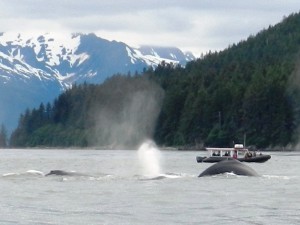 They are taking in a lot of water while they do that, you’re thinking, and you’re right. But humpbacks are baleen whales, which means they have “grooves” on the lower side of their jaw and neck. These grooves expand like an accordion as the whale feeds (like Uncle Morrie’s elastic-waist pants); a whale can take in hundreds of gallons of water and food at one time. After this thrilling lunge up, the whale closes its mouth on the way back down and uses its tongue to force the water out through baleen plates that work like a sieve, trapping the yummy krill, herring, sardines, and mackerel inside. Big Gulp!
They are taking in a lot of water while they do that, you’re thinking, and you’re right. But humpbacks are baleen whales, which means they have “grooves” on the lower side of their jaw and neck. These grooves expand like an accordion as the whale feeds (like Uncle Morrie’s elastic-waist pants); a whale can take in hundreds of gallons of water and food at one time. After this thrilling lunge up, the whale closes its mouth on the way back down and uses its tongue to force the water out through baleen plates that work like a sieve, trapping the yummy krill, herring, sardines, and mackerel inside. Big Gulp!
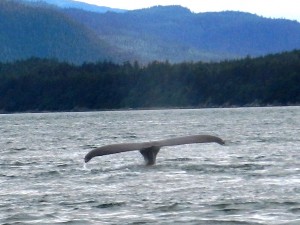 The whale eases back into the water in a gentle curve, giving a satisfied flip of its tail. But I err in referring to a whales “tail” – the correct term is “fluke” and that’s the way you know Who’s Who in the whale neighborhood. The fluke may be as much as 18 feet across and is serrated along its trailing edge; flukes may be gray, white or black, or combinations thereof, each one unique. That’s how Katie knew she’d spotted “Sue” off in the distance – whales that are tracked have ID’s on file; the markings on the flukes are as distinctive as fingerprints. “If you get a photo of a whale’s fluke and want to know who it is, just look it up on the internet,” Katie had explained to us earlier.
The whale eases back into the water in a gentle curve, giving a satisfied flip of its tail. But I err in referring to a whales “tail” – the correct term is “fluke” and that’s the way you know Who’s Who in the whale neighborhood. The fluke may be as much as 18 feet across and is serrated along its trailing edge; flukes may be gray, white or black, or combinations thereof, each one unique. That’s how Katie knew she’d spotted “Sue” off in the distance – whales that are tracked have ID’s on file; the markings on the flukes are as distinctive as fingerprints. “If you get a photo of a whale’s fluke and want to know who it is, just look it up on the internet,” Katie had explained to us earlier.
 So you see, Captain Larry already knew where Sue liked to feed. When Sue was spotted, he knew just where to position our boat to watch “Whale Lunch.” “Can we go to McDonalds when we get back?” Sam asked at the end of our spectacular afternoon. “I’m getting hungry.”
So you see, Captain Larry already knew where Sue liked to feed. When Sue was spotted, he knew just where to position our boat to watch “Whale Lunch.” “Can we go to McDonalds when we get back?” Sam asked at the end of our spectacular afternoon. “I’m getting hungry.”
Sam and I were on the Whale Watching Tour offered by Orca Enterprises in Juneau; “whale sighting guaranteed” was the promise on the website. Our boat, the “Orca Odysea” was “mammal  friendly” and “handicap accessible” and there were in fact two wheelchaired passengers on board. Captain Larry himself pushed both of them to the back deck for the very best view when our whales started feeding. The boat didn’t have a propeller that might injure any animal in the water, he explained to me when I asked what made it “animal safe.”
friendly” and “handicap accessible” and there were in fact two wheelchaired passengers on board. Captain Larry himself pushed both of them to the back deck for the very best view when our whales started feeding. The boat didn’t have a propeller that might injure any animal in the water, he explained to me when I asked what made it “animal safe.”
A bus picked us up at our hotel for the 30-minute ride to Auke Bay; we cruised along the shoreline of Admiralty Island, which has the largest concentration of Alaskan Brown Bears and nesting Bald Eagles in the world. Because we were in the Inside Passage, the waters were calm; we were surrounded by the 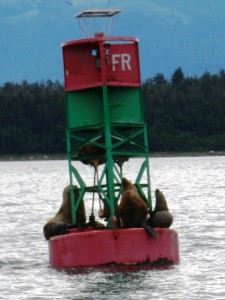 Chilkat Mountains and a few glaciers. Plenty of photo ops, including “Seals on a Buoy” which brought a laugh from everyone; one seal kept swimming around looking for a spot but nobody would move over to let him on.
Chilkat Mountains and a few glaciers. Plenty of photo ops, including “Seals on a Buoy” which brought a laugh from everyone; one seal kept swimming around looking for a spot but nobody would move over to let him on.
Captain Larry was fun, low-key and quiet; he’s internationally known and is considered the most experienced and professional whale watching captain in Southeast Alaska. We were tickled to see he first got interested in whales as a child in Washington’s Puget Sound, our home waters.
Orca Enterprises, 907-789-6801, http://www.orcaenterprises.com/
More about whales @ Marine Education and Research of South East Alaska (MERSEA) http://www.mersea.com/
Save the Whales http://www.savethewhales.org/humpback.html

